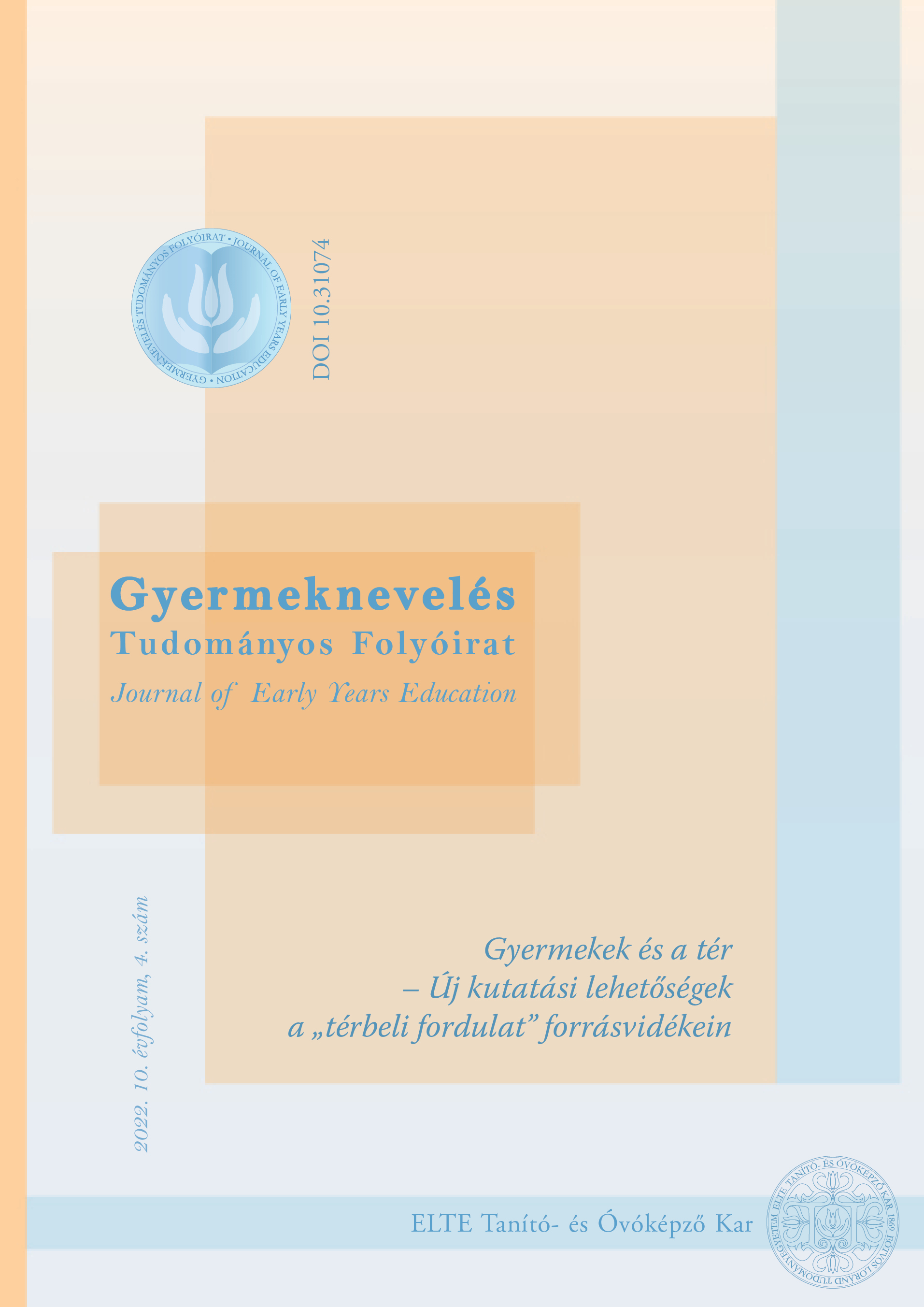Body/space/image – an attempt to approach the museum space and spatial experience from the perspective of the child’s body
DOI:
https://doi.org/10.31074/gyntf.2022.4.300.311Keywords:
museum, body, spacial experience, child, museum educationAbstract
The cultural and social role, status, mission and interpretation of museums have changed significantly over the years. The museum, as a physical body in space and time, perceptible to our senses, is a fundamental element of our interaction with the museum itself. John Dewey’s and Alfred Lichtwark’s innovative ideas on (museum) education have helped to expand the educational space: museums have become an important part of the educational process and education has become a major task of museums. Entering a museum building is a process of inclusion, and the paper explores aspects of this process in the context of the definition of museum space, experience and occupation of space from the perspective of the child’s body, through a review of fine examples, both international and Hungarian.
Downloads
References
Bárd, E. (2010). Drámapedagógia a múzeumban, az emlékházakban. In Gulyás, G. & H. Bagó, I. (Eds.), Múzeumpedagógiai Füzetek 1. A kezdet az egésznek a fele (pp. 109–121). Petőfi Irodalmi Múzeum.
Bárd, E., Szabadhegyi, Z., Szigethy, M. & Szigethy, Zs. (2020). A gyermekbarát múzeum. In Nagy, M. (Ed.), Múzeumi iránytű 28. Fókuszban a közönség. Útmutató a család-, gyermek- és iskolabarát múzeumi működéshez, a múzeumpedagógia, az önkéntesség és az IKSZ minőségmenedzsmentjéhez (pp. 107–135). Szabadtéri Néprajzi Múzeum – Múzeumi Oktatási és Módszertani Központ Szentendre.
Birch, J. (2018). Museum spaces and experiences for children – ambiguity and uncertainty in defining the space, the child and the experience. Children’s Geographies, 16(5), 516–528. https://doi.org/10.1080/14733285.2018.1447088
Borgos, A. (2002). „Testkép-képek”. Áttekintés a fogalom filozófiai és pszichológiai értelmezéseiről. In Csabai, M. & Erős, F. (Eds.), Test-beszédek. Köznapi és tudományos diskurzusok a testről (pp. 46–60). Új Mandátum.
Castells, M. (2012). Múzeumok az információs korszakban. In Palkó, G. (Ed.), Múzeumelmélet. A képzeletbeli múzeumtól a hálózati múzeumig (pp. 30–43). Petőfi Irodalmi Múzeum – Ráció Kiadó.
Dewey, J. (1912). Az iskola és a társadalom. Lampel. https://mandadb.hu/tetel/215688/Az_iskola_es_a_tarsadalom_reszlet
Dewey, J. (1915). The School and Society. The University of Chicago Press.
Douglas, M. (1995): A két test. Magyar Lettre Internationale, 18, 8–11. http://epa.oszk.hu/00000/00012/00002/04.htm
Ébli, G. (2005). Az antropologizált múzeum. Typotex.
Fleming, D. (2019). Global Trends in Museums. Museum International, 71(1–2), 106–113. https://doi.org/10.1080/13500775.2019.1638065
Hackett, A., Holmes, R. & MacRae, C. (2020). Working with Young Children in Museums: Weaving Theory and Practice. Routledge. https://doi.org/10.4324/9780429434457
Hári, K. (2018). Múzeum? Gyerekjáték! Hetedhét Játékmúzeum.
Hofmann, F. (2016). Developing the Model of „Pedagogical Art Communication” Using Social Phenomenological Analysis: an Introduction to a Research Method and an Example for its Outcome. Journal for Learning through the Arts, 12(1), https://escholarship.org/uc/item/6xw4f5c3, http://dx.doi.org/10.21977/D912130227
Hooper-Greenhill, E. (1994). Museums and their Visitors. Routledge.
Joó, J. (2014). A német művészetpedagógia története 1900–1980 között. Neveléstudomány, 2(4), 79–91.
Kállai, J., Karádi, K. & Tényi, T. (1998). A térélmény kultúrtörténete és pszichopatológiája. Tertia.
Kárpáti, A. (2021). Művészetpedagógia a társadalom perifériájára sodródottakért: az AMASS kutatásról. Vizuális kultúra, 1(1), 41–44. http://vizualiskulturaujsag.hu/2021/01/12/muveszetpedagogia-a-tarsadalom-periferiajara-sodrodottakert/
Kárpáti, A. (2023, Ed.). Arts-Based Interventions and Social Change in Europe. Routledge Advances in Art and Visual Studies. Routledge.Kolosai, N. (2022). Anya, menjünk ma múzeumba! – A múzeum mint innovatív kulturális játszótér kisgyerekeknek és családjaiknak. Társadalmi Innovációs Nemzeti Laboratórium–ELTE Tanító- és Óvóképző Kar.
Mauss, M. (2004). Szociológia és antropológia. Osiris.
Merleau-Ponty, M. (2012). Az észlelés fenomenológiája. L’Harmattan.
Németh, A. (1998). A reformpedagógia múltja és jelene. Nemzeti Tankönyvkiadó.
Polenghi, S., Németh, A. & Kasper, T. (2021). Education and the Body in Europe (1900–1950). Peter Lang Verlag.
Priem, K. & Mayer, Ch. (2017). Learning how to see and feel: Alfred Lichtwark and his concept of artistic and aesthetic education. Paedagogica Historica, 53(3), 199–213. https://doi.org/10.1080/00309230.2016.1267779
Read, H. (1943). Education through Art. Faber and Faber.
Schlichter-Takács, A. & Csimáné Pozsegovics, B. (2020). Múzeumpedagógia újragondolva – A kaposvári Rippl-Rónai Múzeum múzeumpedagógiai foglalkozásainak vizsgálata, módszertani megújítása. Gyermeknevelés Tudományos Folyóirat, 8(2), 232–259. https://doi.org/10.31074/gyntf.2020.2.232.259
Takács, A. (2013). A művészeti nevelés jó gyakorlatai hazai múzeumokban – múzeumpedagógia, a pedagógusok nélkülözhetetlen eszköztára. Gyermeknevelés Tudományos Folyóirat, 1(2), 48–56.
Veres, B. (2019). Taktilis taktikák a kortárs kiállítási gyakorlatban. Disegno: A designkultúra folyóirata, 4(1–2), 22–37. https://doi.org/10.21096/disegno_2019_1-2vb
Downloads
Published
How to Cite
Issue
Section
License
Copyright (c) 2022 Author

This work is licensed under a Creative Commons Attribution-NonCommercial-ShareAlike 4.0 International License.

